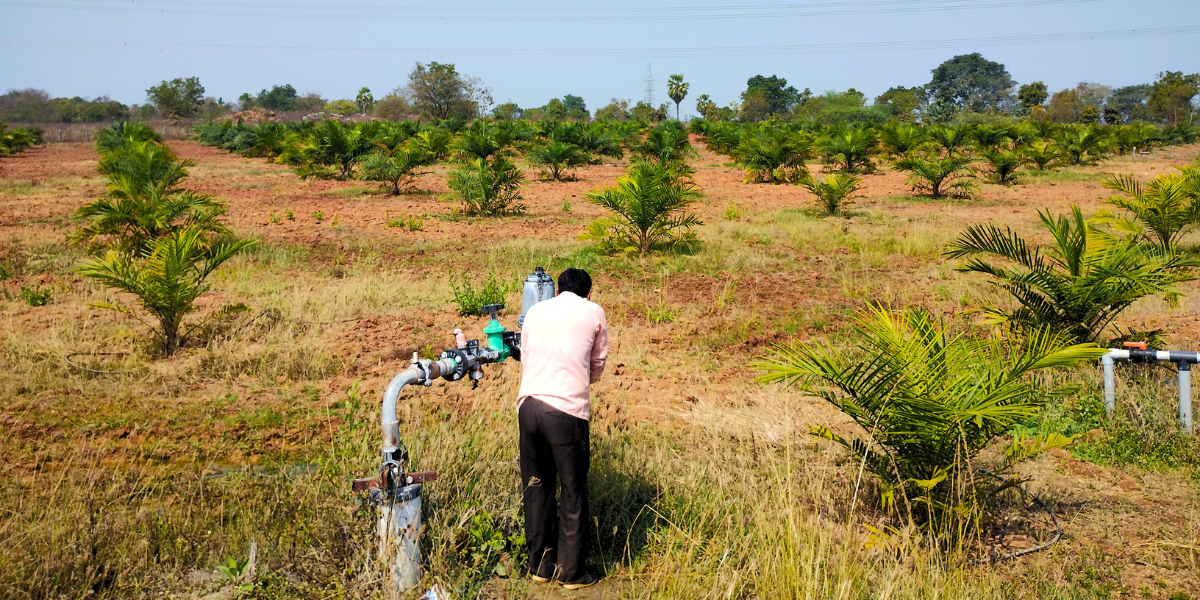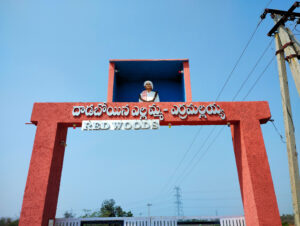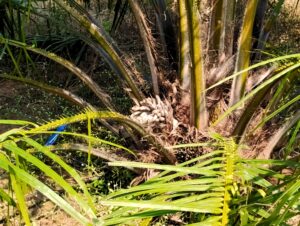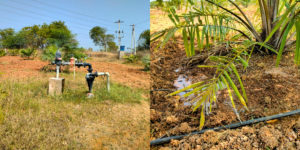The expansion of oil palm farming in Telangana presents a double-edged sword. On one hand, it offers farmers a lucrative opportunity to stake a claim in the growing global edible oil market. On the other hand, environmental concerns loom large—water-intensive cultivation in a drought-prone state, soil degradation from chemical use, and the uncertain market fluctuations tied to global demand could pose significant risks.
Published Feb 09, 2025 | 9:00 AM ⚊ Updated Feb 09, 2025 | 9:00 AM

Telangana's push for oil palm cultivation is a new hope for some although concerns persist
Synopsis: Telangana is looking forward to becoming an oil palm cultivation in the country, and is providing several incentives to farmers. However, it remains to be seen if oil palm farming will become a boon or bane for the state.
Telangana signing a Memorandum of Understanding (MoU) with Hindustan Unilever at Davos for the setting up of a palm oil refinery in the Kamareddy district has further boosted the state’s ambition for becoming an oil palm cultivation hub.
Even as the state doubles down on its oil palm ambitions, the question remains: Will this initiative create a thriving agricultural sector with long-term gains for farmers, or will Telangana’s push for palm oil come at the cost of water security, soil health, and market volatility?
The answer will determine whether this venture is a golden opportunity or a high-stakes gamble.
Major Breakthrough for #Telangana!
Hon’ble Chief Minister Shri @revanth_anumula garu successfully convinced Mr Hein Schumacher, CEO of @Unilever, to set up two manufacturing units in the state, marking a new chapter for investment and growth.
In a strategic meeting with Mr Hein… pic.twitter.com/3C5rMrs8Uc
— Telangana CMO (@TelanganaCMO) January 21, 2025
“One of the reasons that motivated me to turn to oil palm farming is that it doesn’t need many farmhands,” Ranjith Dadaboina, a 45-year-old oil palm farmer, said.

Ranjith installed a bust of his father outside his plantation
“I am in the plantation for about eight to 10 hours daily, checking the trees. All you need to do is to ensure that the trees are disease-free and well-watered. I can manage this work by myself,” he continued.
“I just have to make sure the field is ploughed three times a year, and watch for diseases, pests, and weeds. I supplement the soil with nutrients once in 15 days,” he said.
A small bust sits atop the entrance to Ranjith’s farm at Rampet, about 5 km from Kazipet in Hanamkonda district.
“I am among the few in Rampet who has no job. Earlier, the railways came, offering jobs. However, my father refused employment with the railways. He chose to continue rearing goats, the family’s traditional occupation. He worked hard and bought the land on which we built our house,” he said.
The bust above the entrance is that of Ranjith’s father. “I don’t believe in god. I’d rather pay my respects to the person to whom I owe it all,” he told South First.
With a BA in Sociology from Kakatiya University, Ranjith has a knack for doing things differently and efficiently. He opted for oil palm farming even as others in the locality stuck to the traditional crops.
In the past few years, Inavolu Mandal has seen a new crop emerge in its fields. Traditionally, the area cultivates three primary crops: paddy, wheat, and cotton.

Ranjith tends to his farm for over 8 hours a day.
Alongside the big three, mango orchards and corn crops are also interspersed in the area. However, for those with the means, palm oil is becoming a new alternative, a ‘new wave’ crop of sorts.
“The problem is with the incongruence between practice and sentiments,” Ranjith explained. “The farmers still have a love for traditional crops like rice. Yet, they no longer follow traditional cultivation practices. What was earlier an ecosystem involving plants, cattle, and humans has become a game of getting the largest yield. The chemicals they use to grow the crops are ultimately ruining the soil,” he explained.
For Ranjith, stepping into oil palm farming was a gamble. In 2022, the lands which Ranjith and his three siblings owned fell under the ambit of an upcoming venture. Following the surge in realty price, the the family sold some of its land. While some members of the family chose to renovate or build new houses, Ranjith invested his share in oil palm farming.
“I decided to take this up since it seemed to have the potential to make a profit. However, people told me that I could make three times my investment in this crop,” he recalled.
However, oil palm farming is not for everyone. While the saplings are available at a subsidised price, there are additional costs of power, water, medicine, maintenance, and preparation that go into it.
While Ranjith was able to avail of the 475 saplings on his farm at the price of ₹20 a piece, he had to pay an additional ₹14 lakh to level the field. Furthermore, he had to spend ₹2 lakh on getting a transformer, and about ₹6 lakh to dig and set up three borewells and pumps.
In total, he had to shell out close to ₹22 lakh even before he started planting. The saplings at discounted rate were distributed through the Mandal Agricultural Office.
“It takes at least four years for the crop to mature and provide yield. Therefore, it doesn’t make sense if the plantation is small. If anyone plans on setting up an oil palm farm, it must be at least four acres. If not, they must have an additional source of income,” Ranjith said.

The produce from which palm oil is extracted in Sriramulu’s plantation
The man said he availed a loan of about ₹10 lakh from a commercial bank, and borrowed an equal amount from his family, besides investing the proceeds from the land sale. He grows paddy on guntas near his house, which caters to his needs.
Gajjala Sriramalu is another farmer who has taken up cultivating oil palms. He, too, availed the saplings at a discounted rate. He said his application for saplings was approved after officials tested the soil and availability of water. The entire approval process took six months.
Sriramalu has hired four people to tend to the trees.
“The culture of oil palm farming was present only around the bordering villages of Telangana and Andhra Pradesh. The farms there have been around for over 30 years, now in their second cycle,” Alapati Prasad, president of the Telangana Oil Palm Growers’ Association told South First. He was among the first oil palm farmers in the region.
“Currently, thanks to the push from both Union and state governments, there are some benefits for oil palm farmers. Apart from the subsidised price on saplings, the government also assists with setting up irrigation systems and the sale of products,” he explained.
He further noted that the Union government increased the tariff on palm oil imports, encouraging the purchase of local produce. “However, the price is often volatile and decided by the international markets,” he said.
Speaking in the Lok Sabha on 1 February, Union Finance Minister Nirmala Sitharaman reiterated the government’s commitment to achieve self-sufficiency in edible oil.
“Our government is implementing the National Mission for Edible Oilseed for achieving atmanirbhrata in edible oils. Our farmers can grow enough for our needs and more,” she said.
The Union government listed targets to increase the cultivated area under the National Mission on Edible Oil (NMEO) for 2025-26. It also aims to triple its crude oil output to about 12 lakh metric tonnes this year. Telangana saw about ₹258 crore from the Union and state to develop oil palm cultivation.
In his budget speech from July 2024, Telangana Finance Minister Mallu Bhatti Vikramarka seconded the Union’s focus.
“We have set a target of plantation in 1.00 lakh acres in 2024-25. Registrations have already been made for 77,857 acres and permissions have been given for 23,131 acres,” he explained.
Besides providing subsidised saplings, the governments are also providing ₹4,000 per acre per year as assistance to the farmers.
“I received the assistance for my seven acres in the last two years, I’m likely to get this year’s assistance by March. The government also bears the cost of up to 70% of the drip irrigation system that I had to set up,” Ranjith explained.
The BRS government had earlier come up with the Telangana State Oil Palm Mission. It aimed to bring at least 20 lakh acres under cultivation by 2025-26 following the rules of The Telangana Oil Palm (Regulation of Production and Processing) Act, 1993.
“The BRS government assessed the climate conditions for the crop, identifying zones for production. I think the government’s encouragement of oil palm farming is translating to good yields in the state too. Normally, from about year six, the plantations produce about 10 tonnes per acre. However, in the up-and-coming plantations of Telangana, there has been a good yield of about 4 to 5 tonnes within the first 3 or 4 years, a little higher than what’s normal,” Prasad explained.
Oil palm cultivation spans several countries, with Indonesia and Malaysia being the top producers. They account for approximately 57% and 25% of global production, respectively. Other notable contributors include Thailand, Colombia, and Nigeria.
India was the world’s largest importer of palm oil in 2022. It heavily relies on imports to meet its domestic demand.
In 2022, India imported $11.1 billion worth of palm oil, primarily from Indonesia, Malaysia, and Thailand. Domestic production is limited, and while India exported $39.8 million in palm oil in the same year, this is minimal compared to its imports, indicating a significant dependence on foreign supply.
The profitability of oil palm cultivation is influenced by global demand, driven by its widespread use in food products, cosmetics, and biofuels. In 2025, Malaysian crude palm oil prices are projected to average higher, around 4,350 ringgit ($972.07) per metric tonne, up 5.4%.
However, factors such as adverse weather and competition from alternative oils like soybean oil are changing the pattern. India recently witnessed its lowest import of 2.72 lakh metric tonnes in January, the lowest in over a decade. This is compared to the average of 7.5 lakh metric tonnes in 2024. Most notably, alternatives like soybean oil and sunflower oil ate into palm oil’s market share.
Furthermore, the state and central governments have stepped up efforts to curb the import of edible oil in the last couple of years.
Growing oil palm requires a lot of water. “Each tree on my farm requires about 20 barrels per day. Each barrel is about 20 litres,” Ranjith explained.

Oil palm needs about 400 litres per tree per day.
For Ranjith’s farm of 475 trees, that amounts to 9,500 barrels a day. That is the equivalent of 1.9 lakh litres per day for his entire farm.
To keep their crops well irrigated, Ranjith and Sriramulu rely on groundwater. They use the borewells on their farm to operate a drip irrigation system, keeping the trees hydrated constantly.
“It is a little overwhelming during the summers up until July. Due to the summer heat and lack of rain, it becomes imperative to ensure that the trees are irrigated. However, the monsoons ease the burden. The subsequent winters also prove less daunting than the summers in these parts.
“The farmers seem too optimistic currently in the growing season. They think it will be fine,” Kanneganti Ravi, the general secretary of the Rythu Swarajya Vedika told South First.
“However, the worsening climate conditions could lead to unpredictable repercussions,” he warned.
“Telangana is a relatively dry state, unlike the humid conditions oil palm requires. Both levels of the government are pushing for extreme expansion despite its unsuitability. Furthermore, MSPs will become a major issue, critical to small and marginal farmers,” he noted. Acknowledging the volatile market conditions and change in the supply-demand of palm oil, he said that the farmers will require a safety net.
“It’s also questionable as to how wise it is to push oil palm this much. Such promotion of one specific oilseed hurts the production of others by proxy. Despite its uses, such tunnel-visioned focus might hurt public health in the long run,” he stated.
“Furthermore, the use of chemical fertilisers, weedicides, and pesticides will also deteriorate the already concerning soil health countrywide,” he said.
The expansion of oil palm farming in Telangana presents a double-edged sword. On one hand, it offers farmers like Ranjith a lucrative opportunity to stake a claim in the growing global edible oil market. It also signals long-term viability with the government’s push for self-sufficiency and investment in infrastructure like Hindustan Unilever’s upcoming palm oil refinery in the Kamareddy district.
On the other hand, environmental concerns loom large—water-intensive cultivation in a drought-prone state, soil degradation from chemical use, and the uncertain market fluctuations tied to global demand could pose significant risks.
Furthermore, prioritising oil palm over other crops might create imbalances in agricultural sustainability. While the government’s support is encouraging, the true impact of this ambitious push remains uncertain.
Whether Telangana’s farmers will reap long-term rewards or face unforeseen consequences will depend on how the industry navigates these environmental and economic challenges in the coming years.
(Edited by Majnu Babu).
